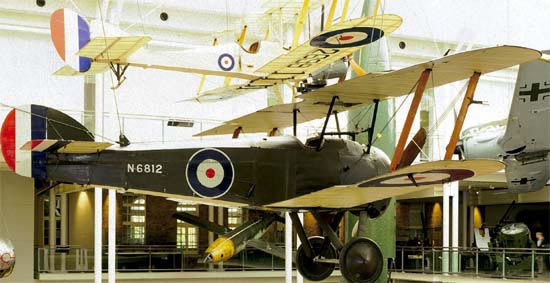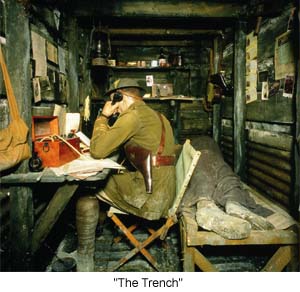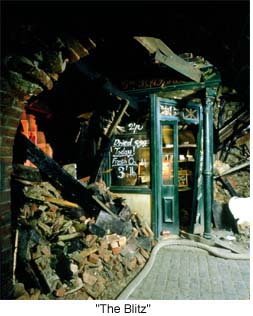The Imperial War Museum
by Sean McLachlan
For travelers interested in military history, a visit to London should include the famous Imperial War Museum. Located in a quiet neighborhood south of the Thames, it is in easy walking distance from Waterloo International Railway Station or the Elephant & Castle Tube stop. The museum contains England's largest display of military artifacts, ranging in period from the First World War to the present day.
The front hall is a vast space under a high glass roof. Here large exhibits such as tanks and airplanes are displayed. A German V2 rocket, the terror of the London Blitz, towers over the scene. Around it are lumbering tanks from the First World War, intimidating artillery from the Second, and a variety of equipment from several armies. Overhead hang airplanes, including a WWII British Spitfire and a Sopwith Camel, the biplane flown by Snoopy in his cartoon hunts for the Red Baron.

Beyond the front hall are a wide array of exhibits on several floors. Glass cases display uniforms, documents and weapons from Britain's various modern wars. Films and interactive video displays make this museum and engrossing, interactive experience.
Extensive space is given to the First World War, a cataclysmic conflict that killed millions in Europe and still figures large in British consciousness today. It was the first truly modern war, as the hundreds of machine guns, grenades and gas masks attest. Uniforms and armaments from all participating armies are on display, including lesser-known forces such as Bulgaria and Montenegro. The home front is represented too. One amusing artifact is a postcard sent by the leader of a local Girl Scout troop to a railway employee who had failed to enlist. It invited him to join the Girl Scouts, since it was obvious he wasn't a man!
 One of the most fascinating exhibits is a reconstruction of a First World War trench. Here visitors can walk through the sights and sounds of a trench at night. Uniformed mannequins, voice overs and sound effects add even more authenticity. The museum has done an excellent job recreating the cramped, disorienting life in a ditch that was so familiar to the soldiers of that war. When one remembers that in the real trenches there was mud, artillery bombardments and the stench of dead bodies, one wonders how people were able to stand it for months and years on end. One of the most fascinating exhibits is a reconstruction of a First World War trench. Here visitors can walk through the sights and sounds of a trench at night. Uniformed mannequins, voice overs and sound effects add even more authenticity. The museum has done an excellent job recreating the cramped, disorienting life in a ditch that was so familiar to the soldiers of that war. When one remembers that in the real trenches there was mud, artillery bombardments and the stench of dead bodies, one wonders how people were able to stand it for months and years on end.
The displays for the Second World War are equally impressive. One shows the struggles of the British soldiers in the Burma campaign, including the harrowing experience of being a prisoner in a Japanese POW camp. A recording from a veteran explains how he treated open sores on his legs with tea bags because he had learned that tea is a disinfectant. This trivia saved his legs and probably his life.
The Secret War gallery highlights the role espionage has played in modern conflict. The British cracking of the Nazi Enigma code is given pride of place. The breaking of this code saved countless Allied lives and was a major factor in winning the war. There are also fascinating exhibits on British spy activities in the Cold War.
 Other galleries include a reconstructed 1940s house, information on the famous "Desert Rat" Field Marshal Montgomery, and sobering sections on the Holocaust and other crimes against humanity. The entire museum takes the better part of a day to see, but since admission is free it is well worth going even if time is limited. There is a cafe serving food and drinks on site. Avid readers should be warned that the bookstore is extremely dangerous to the bank account. Other galleries include a reconstructed 1940s house, information on the famous "Desert Rat" Field Marshal Montgomery, and sobering sections on the Holocaust and other crimes against humanity. The entire museum takes the better part of a day to see, but since admission is free it is well worth going even if time is limited. There is a cafe serving food and drinks on site. Avid readers should be warned that the bookstore is extremely dangerous to the bank account.
While strolling through the museum, pay attention to the conversations of other visitors. The wars of the twentieth century affected all British people and many come here to remember and discuss their experiences. This eavesdropping writer was entertained by a conversation between an old Englishman and his grandson in the main hall. They were standing by the V2 and the man was talking about his memories of those rockets landing in London. He vividly recalled the strange buzzing sound they made as they came down. The first time he heard it he knew instantly that the Germans were using a new kind of weapon, and that he would be hearing it frequently from them on. In another conversation, near an exhibit from the Falklands War, a veteran of that conflict recounted the harsh conditions of the islands. He remembered how the Argentine soldiers were badly provisioned and were grateful for hot food when they surrendered.
The museum also operates the Cabinet War Rooms, a series of underground bunkers from which Prime Minister Sir Winston Churchill directed the war during the bombing raids on London. On the same grounds is the Churchill Museum with displays on the life and career of Britain's most famous prime minister. The Imperial War Museum has separate locations at Duxford, Belfast and Manchester. It also operates the HMS Belfast, a cruiser that served in WWII and Korea. It is currently moored on the Thames near London Bridge. See the website below for more details.
The Imperial War Museum is located on Lambeth Road, London. Admission is free and is open daily from 10 am to 6 pm. Some special, temporary exhibits cost a fee. Call ahead for details at +44 (0)207 416 5320.
Among the exhibits in the atrium or "large exhibits gallery" (viewed from the right balcony) are the "Ole Bill" London bus (used as a troop transport during WWI); a British 18-pounder artillery piece from WWI; a 1918 Mark V tank; a German mast periscope used for viewing from behind buildings or in woods; WW2 searchlights; rocket launchers; the British BE2c two-seat reconnaissance aircraft; the Sopwith Camel 2F1 from WWI; and the American P-51 Mustang.
More Information:
We regret that we no longer have the resources to maintain up-to-date links and/or hours and pricing details for the various sites and attractions listed on this website. For more information about the location(s) listed above, please use your favorite search engine or visit Wikipedia.
Article © 2005 Sean McLachlan
Photos courtesy of the Imperial War Museum
| 